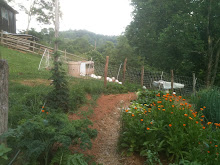I want to clear something up. I started this blog with the intention of chronicling the progress of my permaculture site, Sweet Aspect Mini-Farm. The farm is near Mars Hill, NC, zone 6ish (somewhere between 6 and 7). I am also the gardener at the Penland School of Crafts. In that capacity, I care for ornamental flower beds adjacent to dozens of buildings. I also started a food growing operation and acquired a permit to compost most of the organic waste the kitchen produces. I helped develop a forest stewardship program to manage the undeveloped portion of the 400-acre campus. The difference in elevation between the two sites is about 1,000 ft. There are many differences between the Penland and Sweet Aspect, so I'll start to be more clear about which one I'm talking about.
At Penland this week, I tilled in all of the compost and Complete Organic Fetilizer (COF) I laid on 6 out of the 12 100' rows within the last couple of weeks. I wound up using about 8 quarts of the COF on each row and about an inch of compost from 2009. On Tuesday, I even planted a 100' single row of 2009 Winter Bloomsdale Spinach from Southern Exposure Seed Exchange (SESE). I also did a 30' single row each of Ruby Streaks Mustard from the 2010 Organic Growers School, 2009 Tat Soi from SESE, and 30' of 2011 Sow True Seed's Appalacian Greens Mix, a combination of Seven Top Turnips, Champion Collards, and Green Wave Mustards. I hope they survive the next cold wave if they come up within the next week.
Before I tilled, I used a really handy trick to see if the soil's ready in clay conditions: take a handful of garden soil and make a ball with the soil in one hand. Stick the thumb of the other hand into the ball of soil. If it crumbles, you know the soil is ready for working. If you're not able to make a ball, you know the soil is too dry and if the thumbprint remains and the ball stays intact, you know the soil's too wet. If you till when the soil's too dry, the soil will slump the next time it rains and you will be left with an airless, concrete-like slab. If you till when the soil's too wet, the tiller will cause clods in the soil which will become like stones or bricks instead of the fluffy crumbly brown soil we all love.
